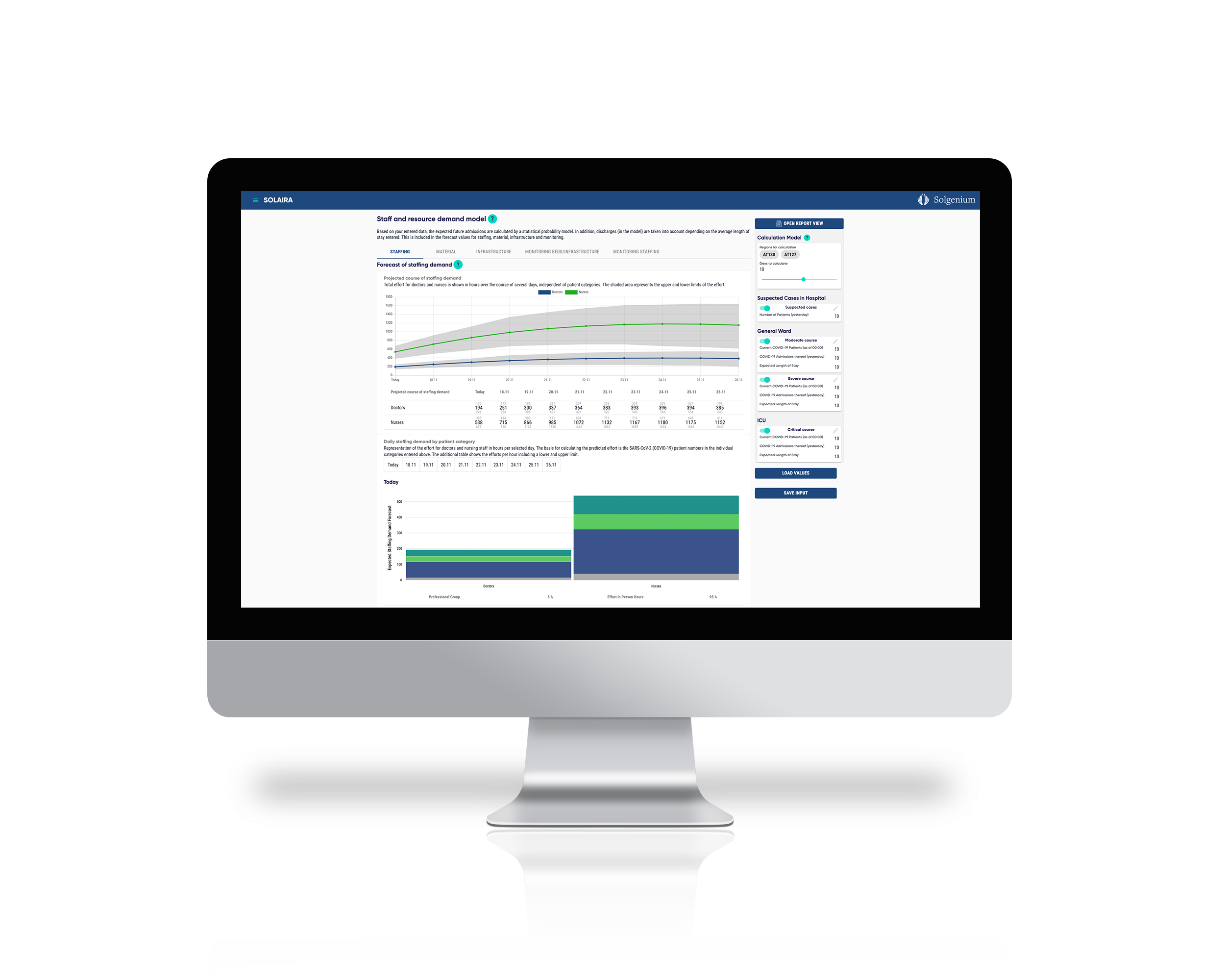Intuitive input of parameters
Only three key figures per patient category as well as the desired region(s) are needed for a meaningful result. The individual forecast period can be easily adjusted using a slider.
With COVID-19, a global challenge must be mastered. We have developed SOLAIRA, a cloud-based dynamic personnel and resource demand model that can predict the ongoing personnel, infrastructure and material requirements for COVID-19 patients.
Web-based personnel and resource demand model for COVID-19 patients
SOLAIRA provides a forecast of the expected COVID-19 cases in a region for the next few days - at hospital, institution or state level for better management of supply.

SOLAIRA is based on COVID-19 data available from the previous day for a particular country. COVID-19 case data is subdivided into: suspected cases; confirmed cases in the normal ward an critical; and intensive care cases at the intensive care unit. Furthermore, the tool shows the estimated effort for the doctors and nurses for these specified patient cohorts. This effort is made up of activities related to admission, dicharge/transfer, patient-specific nursing and doctor activities as well as additional expenses due to COVID-19 (hygiene, isolation, etc.).

SOLAIRA offers interactive, freely selectable input fields relating to COVID-19 patients. These include the entry of suspect cases in the hospital, inpatient COVID-19 patients on normal wards with a moderate or severe course and inpatient COVID-19 patients on ICU with a critical course.

SOLAIRA provides a forecast of inpatient admissions due to COVID-19 for the next few days in the respective categories.

The cumulative COVID-19 patient volume is predicted. This means the forecast of new admissions plus inpatient patients minus outpatient patients.

SOLAIRA forecasts the total staffing requirements (doctors and nursing staff) for the next few days in connection with COVID-19 patients (including fluctuation range).

SOLAIRA offers ongoing, customisable personnel and resource monitoring (bed status occupied, personnel available, ventilation places available, etc.)

Integration of regions at NUTS-3 level and consideration of regional differences in the calculation model.
In this project we aim to contribute to the control and prevention of infection in the ongoing COVID-19 pandemic, by establishing a data-driven hierarchical Bayesian inference framework for modeling regionally and demographically varying COVID-19 infections under different conditions of non-pharmaceutical interventions. This will power decision and planning support services to help healthcare officials in managing critical resource demand and elective care services, and allow political decision makers to anticipate the effects of non-pharmaceutical interventions from earlier phases of evolving outbreaks and evaluate the effect past interventions.
During the initial phase of an epidemic disease wave, realistic epidemiological models usually show a very strong sensitivity to the precise values of a comparably small number of highly volatile data points. This is not a flaw in the models themselves, but rather a generic feature of infectious disease waves and their dynamics. Often, this simple fact is masked by making the models more complicated via the introduction of many parameters with unnecessarily complex interactions with one another — sometimes even at the cost of omitting any quantification of the uncertainties involved. On the other hand, even the most advanced of these models, although requiring very demanding highperformance computations, are still not fully capable of accurately predicting the complex details of the dynamics of epidemic disease waves. Given the urgent need for practically useful, yet mathematically rigorous, sources of more reliable forecasts with clearly-stated uncertainties during earlier stages of an epidemic disease wave, we propose a different, more conservative, datadriven approach.
We aim to use the simplest possible model that is still capable of reflecting the generic features of a given epidemic disease wave, while being applicable in a Bayesian inference framework to yield a quantitative description with uncertainties of the current macroscopic state of the outbreak, from recent case data. In order to account for the effects of countermeasures and regional demographic differences, we aim at a data-driven approach by extending the inference framework to account for hierarchical structures to maximally pool available information from past observations of disease outbreaks.
In the given context, this is an open research direction, although similar strategies were taken in other fields of complex dynamic systems under more controlled experimental conditions. Conditional on a successful outcome in the context of the current COVID-19 situation, we furthermore see a huge potential to tackle similar events, such as the yearly flu or the increasingly frequent occurrence of heatwaves. Additionally, environmental factors such as varying climate condition.
